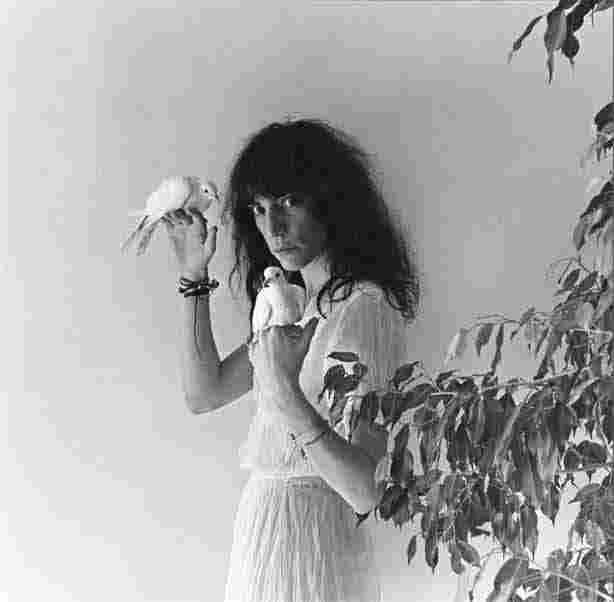|

Patti Smith 1979 © Robert Mapplethorpe Foundation. Used by permission
AN EXHIBITION of photographs by the acclaimed American photographer Robert Mapplethorpe is now on show at Linlithgow Burgh Halls. The collection of around twenty superb photographs is an impressive show by a world-class photographer - a conjurer in grey, black and white.
His work is on a par with the legendary Cecil Beaton, but with a darker side He could be thought of as the Caravaggio of the camera the way he manipulates the medium in an almost painterly fashion, capturing dramatic chiaroscuro effects.
The portrait of Andy Warhol, for example, appears as a disembodied floating head with contrasting black and white zones building up an image, which is stark to the point of discomfort.
His more traditional society type portrait shots of Truman Capote (1989), Louise Bourgeois (1982), and Eva Amurri (1988) are certainly of the quality of Beaton, however, they clearly have the Mapplethorpe stamp on them.
The photograph of Louise Bourgeois, for example is characterised by the phallic object she is holding (possibly one of her own works). The photographs are traditional in their use of props such as Capote's sunglasses, Bourgeois' phallic sculpture and Amurri's cuddly toy rabbit.
Some of the photographs function on a sculptural level focusing mainly on the human form. In the photograph of Arnold Schwarzenegger (1976) it might seem to be all about the body. He is shown in the classic body-builder pose popularised by Charles Atlas, yet the composition hints at something more. The bulk of Schwarzenegger's body is set off to one side, the other side of the picture space being filled with a heavy swept-back curtain.
|
This sculptural and somewhat classical aspect of the work is reinforced in photographs such as Derrick Cross (1983), which shows a male torso, and Ken Moody (1983) a male head and shoulders. Both images work with light and shade to create a sense of weightiness and solidity. Moody's closed eyelids evoke a feeling of being weighed down; the skin appears to have the texture of mahogany or marble.
Two nude studies of Lisa Lyon (1982) differ from the nude Patti Smith (1976). Lyon is depicted to suggest a kind of Playboy playfulness whereas Smith appears vulnerable as she clings to a radiator beside a bare brick wall posed in a foetal-like position.
Again the image has a sense of being weighted down, which contrasts, noticeably with the other image of Smith from 1979 where she holds two white doves. In this photograph there is a feeling of weightlessness, with her light muslin dress and slender form she could almost fly away with the birds she has perched on each hand.
While Smith might fly away Lindsay Key (1985) seems to be on the verge of being blown away. This is a heartbreakingly wistful image of a little girl in a white dress with bare feet; she is shown in profile, her hair blowing across her face as she stands on what looks like an urban street. It is the impermanence of youth being symbolically swept away before the viewer's eyes, both beautiful and sad at the same time.
In the course of a handful of images Mapplethorpe runs the gamut of expression from the outrageousness of Grace Jones to the sophistication of Truman Capote, the self-assuredness of Louise Bourgeois to the inscrutability of Andy Warhol.
He plays with ideas of light and shade, lightness and heaviness, superficiality and pathos.
There are four self-portraits in the exhibition two from 1980, one from 1983 and a later one from 1988 the year before he passed away. The two early photographs and the later one are interesting in that they clearly reveal Mapplethorpe speedily maturing within the space of just a few years, the defiance of youth turning to a kind of resigned worldliness in later years.
However, could there be a fifth self-portrait hidden in the exhibition? Looking closely at The Snake Man (1981) it is possible to imagine that it is Mapplethorpe himself depicted wearing a mask with a snake wrapped around his body. The image is reminiscent of the Roman sculpture Laocoon With his Sons (25 BC) having a distinctly classical look, strangely though the unknown sitter is wearing a contemporary wristwatch and, bearing in mind Mapplethorpe's liking of props, this would seem deliberate. If this were Mapplethorpe, it would seem that he considered himself a renaissance man who was still completely rooted in his own time.
CATHY BELL
The Gallery, Linlithgow Burgh Halls, until October 28
|